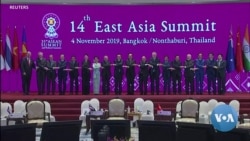On the same week that the Trump administration published a report outlining its engagement in the Indo-Pacific and “commitment to its future prosperity,” President Donald Trump skipped important summits in the region and sent a low-ranking delegation instead.
The report underscored that Trump “has made U.S. engagement in the Indo-Pacific region a top priority of his administration.” Yet Trump did not even send Secretary of State Mike Pompeo to the Association of Southeast Asian Nations (ASEAN) and East Asia summits this week in Bangkok, Thailand.
Last year, Trump sent Vice President Mike Pence to the ASEAN and East Asian summits in Singapore. This year, the president appointed national security adviser Robert O’Brien as the special envoy for the summits.
Critics say the absence of Trump’s senior officials meant other regional powers have greater opportunity to exert their influence.
“If the administration is serious about shifting its attention to the Indo-Pacific, the first thing it has to do is show up,” said Zack Cooper, a research fellow on U.S.-China strategic competition at the American Enterprise Institute.
“The center of gravity in the competition with China is the alignment of regional states. We have to stop shooting ourselves in the foot,” Cooper added.
Chinese Premier Li Keqiang, Japanese Prime Minister Shinzo Abe and Indian Prime Minister Narendra Modi are among the leaders who met with their ASEAN counterparts during the summit.
Adhering to diplomatic protocol, South East Asian leaders did not show up for the U.S.-ASEAN meeting, and sent their foreign ministers to meet with O’Brien, who rejected suggestions that Southeast Asian leaders skipped the meeting as a snub to the U.S.
"I had a great set of meetings and didn't feel like there was anything at all untoward," he said.
O’Brien extended Trump’s invitation to Southeast Asian leaders to a summit in the U.S. early next year, and reiterated “the rock-solid American commitment in word and deed to our friends, allies and partners in ASEAN."
The "divergence between U.S. public statements and the reality of its engagement will make it more difficult to engage Southeast Asia, which needs to be assured of U.S. staying power" in the region, Cooper said.
Interest in US engagement
Trump hosting a meeting of Southeast Asian leaders could be a step forward in U.S.-ASEAN relations, said Brian Harding, deputy director and fellow of the Southeast Asia Program at the Center for Strategic and International Studies.
“I'm sure they'll take the the invitation seriously. There is an interest in the United States being more deeply engaged, and for making a joint trip to the United States,” Harding said.
In 2016, President Barack Obama hosted the first American summit meeting with Southeast Asian leaders in Sunnylands Estate, California, as part of his “pivot to Asia” strategy.
The meeting was considered a watermark moment in Washington relations with a region situated in the backyard of its biggest rival, China. “Sunnylands still resonates in the collective memory of political leaders in Southeast Asia,” Harding said.
Until then, Harding and other critics say Washington's viewpoint is missing on regional negotiations, including on free trade, where China is dominating.
Multilateral free trade agreements
Without the U.S., regional negotiations continue, including discussions of a new free trade agreement, initiated by Beijing, that are underway at the summit and could potentially include at least 15 countries.
Despite the withdrawal of India, which is concerned about the flood of cheap Chinese goods hurting its industries and small businesses, the Regional Comprehensive Economic Partnership (RCEP) is expected to launch next year.
When operational, the agreement would be the world’s largest, including 30% of global GDP and half of the world’s people.
"It definitely will play a crucial role in promoting regional economic integration and cooperation across the board, especially the trade and investment,” Chinese Vice Foreign Minister Le Yucheng said at the sidelines of the Bangkok summit.
Another multilateral deal, the Comprehensive and Progressive Agreement for Trans-Pacific Partnership (CPTPP), is also moving along without Washington.
After Trump in 2017 pulled out of the Trans-Pacific Partnership, the central element of the Obama administration’s “pivot to Asia” strategy, Japanese Prime Minister Abe rallied the 11 other members to rebrand it as the Comprehensive and Progressive Agreement for Trans-Pacific Partnership.
CPTPP was signed in March 2018 and already in force for seven of the 11 signatories.
The Trump administration prefers bilateral trade agreements but has not yet struck any in the region, Harding said.
“Japan has really slow-walked the bilateral trade negotiations as much as they can. Vietnam who seemed to be a possibility is just not interested. The Philippines is not interested,” Harding said. “They look at how the United States has treated its closest allies and partners -- Canada, Mexico, Europe, Korea -- and they don't want anything to do with it.”
Meanwhile, the trade war between the U.S. and China continues to worry ASEAN leaders, with some expressing their opinion more strongly than others.
"America allows only two terms to each president," Malaysian Prime Minister Mahathir Mohamad said. "So at the very worst, this is going to go on for another five years. If he wins.”












